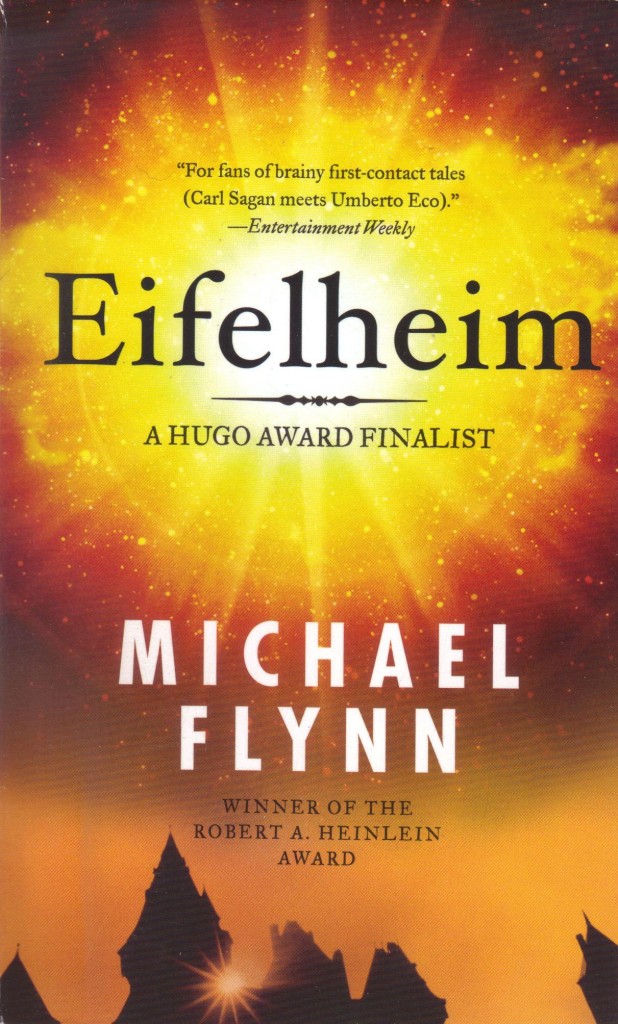 Eifelheim is largely set in the late Middle Ages in and around an unremarkable village in the German forests south of Strasbourg in the vicinity of Freiburg.The book follows the aftermath of the emergency ‘landing’ of a Krenkish vessel in the Great Woods near the village of Oberhochwald. The giant grasshopper-like aliens, some of whom are injured, are discovered by the local priest, Dietrich, and Max, the right hand man of the benevolent local lord, Manfred. Dietrich, whose theology is informed by his rational, intellectually rigorous education in Paris, soon realises that the visitors are not demons, as some villagers would have, but travellers from afar. With Hilde, a village woman, he tends the injured and they gradually, with a standard SF computer translation device, come to communicate. The book is at its most fascinating in addressing the fraught and complex process of understanding (and misunderstanding) between medieval and alien minds.
Eifelheim is largely set in the late Middle Ages in and around an unremarkable village in the German forests south of Strasbourg in the vicinity of Freiburg.The book follows the aftermath of the emergency ‘landing’ of a Krenkish vessel in the Great Woods near the village of Oberhochwald. The giant grasshopper-like aliens, some of whom are injured, are discovered by the local priest, Dietrich, and Max, the right hand man of the benevolent local lord, Manfred. Dietrich, whose theology is informed by his rational, intellectually rigorous education in Paris, soon realises that the visitors are not demons, as some villagers would have, but travellers from afar. With Hilde, a village woman, he tends the injured and they gradually, with a standard SF computer translation device, come to communicate. The book is at its most fascinating in addressing the fraught and complex process of understanding (and misunderstanding) between medieval and alien minds.
There are fractions within the Krenkish and human camps alike, though the reader sees everything through Dietrich, who in perhaps the book’s one major contrivance, is a rather more intellectually gifted man than might be expected for a remote village priest. His reasons for living in self-imposed exile form a counterpoint to the alien story and Dietrich’s gradual redemption and forgiveness for past sins intertwines aptly with the Krenken accommodations to medieval life. Eventually some of the Krenken move from the woods into the village, travellers bring tales of the wider world, tensions rise between villagers and aliens and rumours of demons begin to spread abroad. Meanwhile the Krenken struggle with primitive resources to repair their ship before their essential food supplies run out.
Over the course of the book we see a year in the life of the village, and Michael Flynn paints a rich portrait of a civilisation almost as alien and impenetrable to us as the Krenkish culture is to Dietrich. It does not make for an easy read, especially as the author uses many unfamiliar words and terms, and regularly includes short passages in Latin and German. The result is challenging, an initially rather dry and forbidding, but ultimately a very rewarding book. A novel which requires slow and careful reading, and often re-reading, to fully absorb the breathtaking array of details and ideas which comprise its weave.
The events take place over the year between August 1348 and July 1349. Anyone with a passing knowledge of European history will realise the significance of these dates, as indeed will anyone who has read Connie Willis’ 1993 Hugo Award winning novel Doomsday Book. Perhaps because it is the second Hugo nominated novel to arrive at this particular juncture, Eifelheim, despite being far better imagined work than Doomsday Book, failed to take home its own Hugo.
Eifelheim is based on Michael Flynn’s novella of the same name, originally published in the December 1986 Analog, and subsequently nominated for a Hugo Award in 1987. The novel version was also nominated for a Hugo, but lost out to Vernor Vinge’s less impressive but more accessible Rainbows End.
The novella was set entirely in the then present, and the novel contains present day sections which derive from the earlier work. These chapters, written in a rather arch, almost exaggeratedly formal style, follow the relationship and researches of an historian, Tom, and a physicist, Sharon. Tom has become fascinated with the mystery of a German village, Eifelheim, which was abandoned in the 14th century and which despite all the geographical advantages of its location was never resettled. Sharon meanwhile is absorbed with the implications of the speed of light becoming measurably slower, and what this might mean for our understanding of the universe. These chapters only comprise 57 pages of a novel which, deducting contents list, map, list of characters and three sets of notes, runs a comparatively brief 292 pages. Inevitably Tom and Sharon’s individual enquiries inform our understanding of the main, medieval, part of the novel.
Eifelheim is a rather detached and intellectual first contact adventure – the cover of the Tor edition I read suggests “Carl Sagan meets Umberto Eco” – which rigorously fashions a meeting-place between two alien worldviews, medieval Christian theology and cutting edge physics, without doing disservice to either. Flynn’s large cast of characters are fully realised, though perhaps ironically his medieval cast feels more alive and human than his rather dry and over-cerebral moderns.
Meticulously researched and staying very close to known history – Flynn notes the few points where he has made minor changes to make the tale flow better – the result is a book which must inevitably be compared to Willis’ Doomsday Book. Against that benchmark Eifelheim is far more intellectually and imaginatively satisfying, not to say historically accurate, if not so emotionally engaging or compelling. If you love hard SF, in all senses of the term, then Eifelheim comes with the highest recommendation.
*
An earlier version of this review appeared in Vector #256.










